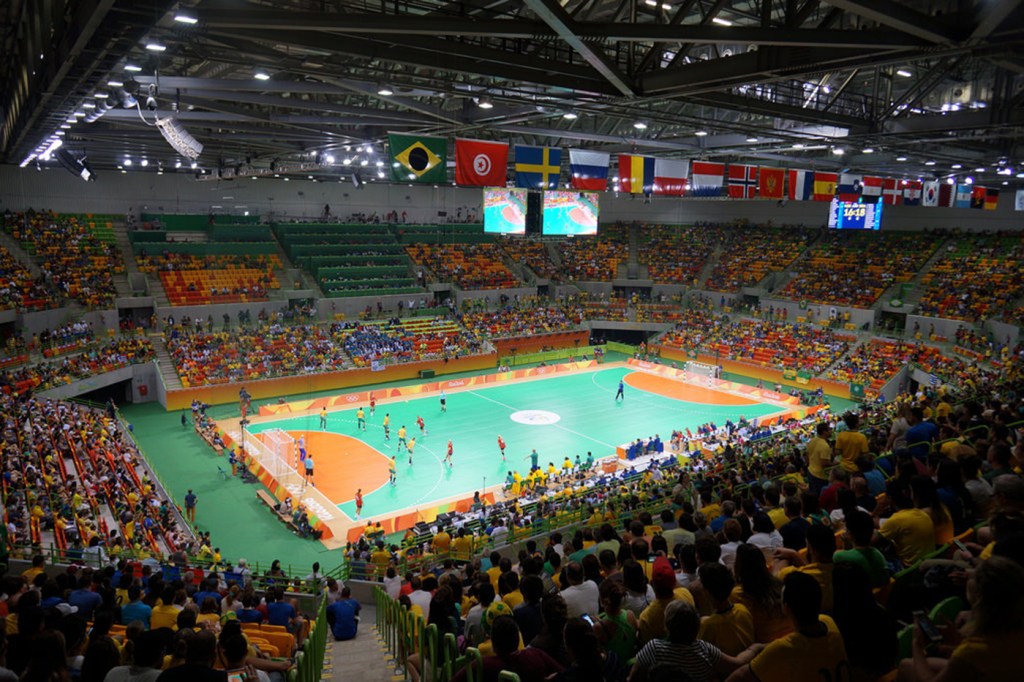3Qs: How ‘nomadic architecture’ will shape Rio’s Olympic legacy

Two venues at the 2016 Summer Olympics in Rio de Janeiro—the 12,000-seat Future Arena, which is hosting handball, and the 15,000-seat Aquatic Stadium, which is hosting swimming and water polo—will be dismantled and rebuilt into entirely new buildings following the games. The Future Arena will be taken down and transformed into four state-run schools in the host city, while the Aquatic Stadium will be converted into two smaller water sports venues, both of which will include Olympic-size swimming pools.
 How might Rio’s reliance on “nomadic architecture”—that is, buildings that can be taken apart and then transformed into other structures in other locations—impact the city’s Olympic legacy? We asked David Fannon, architect, building scientist, and assistant professor with joint appointments in the School of Architecture and the Department of Civil and Environmental Engineering at Northeastern University.
How might Rio’s reliance on “nomadic architecture”—that is, buildings that can be taken apart and then transformed into other structures in other locations—impact the city’s Olympic legacy? We asked David Fannon, architect, building scientist, and assistant professor with joint appointments in the School of Architecture and the Department of Civil and Environmental Engineering at Northeastern University.
Rio officials have said that the majority of the structures that have been designed for the games—including the Aquatic Stadium, the Future Arena, and Barra Olympic Park—will be rebuilt or repurposed to leave a long-lasting social, sporting, and educational legacy. How do you see Rio’s commitment to reusing or rebuilding these Olympic venues affecting the people of Brazil in the decades to come?
Architecture designs the future world, so although buildings are only one aspect of the games, the commitment to reuse or rebuild represents an important legacy. Most host cities—including Rio—cannot support the size and number of athletic venues required for the games, and some previous Olympic facilities are underused or simply abandoned. The International Olympic Committee requires hosts to plan a positive post-competition legacy, and Rio plans to reuse some sporting facilities and reconfigure others into new schools and community pools, distributing the benefits of the material, cultural, and financial investment. Short-lived buildings are generally unsustainable, so repurposing the venue after a two-week athletic event may be obvious. However, dynamic social, economic, and climatic contexts mean that all buildings change over time, so faculty and students in Northeastern’s School of Architecture are developing future use buildings that enjoy multiple productive lives even in the face of uncertainty. Olympic buildings, because the games themselves are ephemeral, also act as potent symbols: beginning before the torch is lit and enduring long after it is extinguished. So while rebuilding and reusing particular Olympic buildings promises local economic, social, and environmental benefits, the broader impact for Brazil and the world stems from developing and demonstrating building’s evolution.
Rio’s nomadic venues feature puzzle-like compositions of shared components, including standardized steel columns, modular steel panels, and concrete slabs that will be disassembled, hauled to new locations, and then reconfigured. In general, what are the pluses and minuses of using nomadic architecture to design massive buildings? In particular, what are the biggest architectural challenges facing Brazil when it comes to reusing this Olympic infrastructure for future projects?
World-class athletic facilities are inherently specialized and therefore difficult to use for any other purpose. When whole buildings are neither needed as is, nor easy to change to another use, reusing components—as in Rio—can be appropriate. Intentional design for disassembly meets future needs by removing limitations of specific buildings’ use, configuration, and location, while preserving the material, energy, and economic resources they embody.
Design for disassembly presents two broad challenges. First, components must come apart fairly easily and cleanly, which precludes most adhesives, sealants, and other “wet” construction processes. Joints within systems, such as bolting beams and columns together, may be straightforward. However, joining different materials and systems while providing adequate performance presents significant design challenges. For example, a team in the Department of Civil and Environmental Engineering is researching demountable connections that yield continuous control of air, water, and heat across the façade. Second, the disassembled components and assemblies must support the design of the next building, which depends on the dimensions of the parts and modules. Generally, larger parts limit the number and variation of possible buildings that can use them, while overly granular disassembly can limit performance and squanders the efficiency of reuse. Rio’s plan addresses both challenges by designing in advance how to reconstitute the constituent parts.
What architectural lessons do you think the host cities of the 2018, 2020, and 2022 Summer and Winter Olympics have learned by watching how Brazil has gone about building stadiums for its games?
Previous host cities have demonstrated mixed-success reusing their athletic venues: employing design strategies like reducing seating capacity (e.g., London and Beijing) or financial methods such as endowing permanent funds for maintenance and programming (e.g., Salt Lake City and Vancouver). That record suggests Rio’s contribution—designing for the reuse of building components after the games, rather than seeking uses for the buildings as a whole—offers another valuable approach for cities to include in their planning toolkit.
Of course, hosting the Olympics requires large and diverse athletic infrastructure. However, the games also demand significant civic and urban infrastructure including transit, housing, utilities, and public space. These two infrastructures are different, and though less visible, the urban infrastructure generally contributes more to a positive Olympic legacy for citizens of the host city. The 1992 Barcelona Games are widely cited as a successful catalyst for urban revitalization, not because of the athletic venues, but because they worked to expand public space, transportation networks, and water systems to change the face and identity of the city. So perhaps the most important lesson of Rio’s nomadic architecture lies in its ability to transform athletic venues in the Olympic park into beneficial civic buildings across the city and region.





